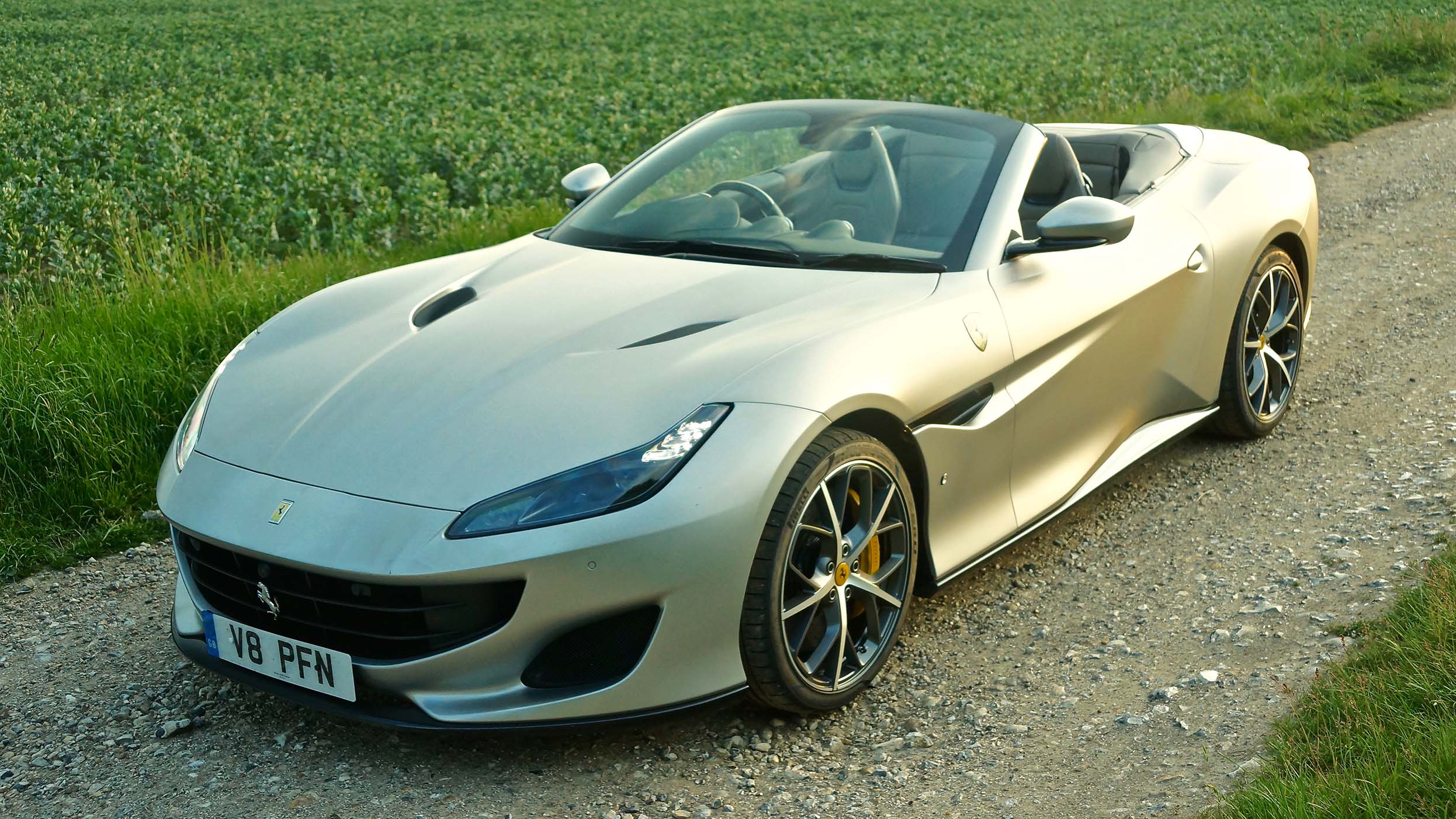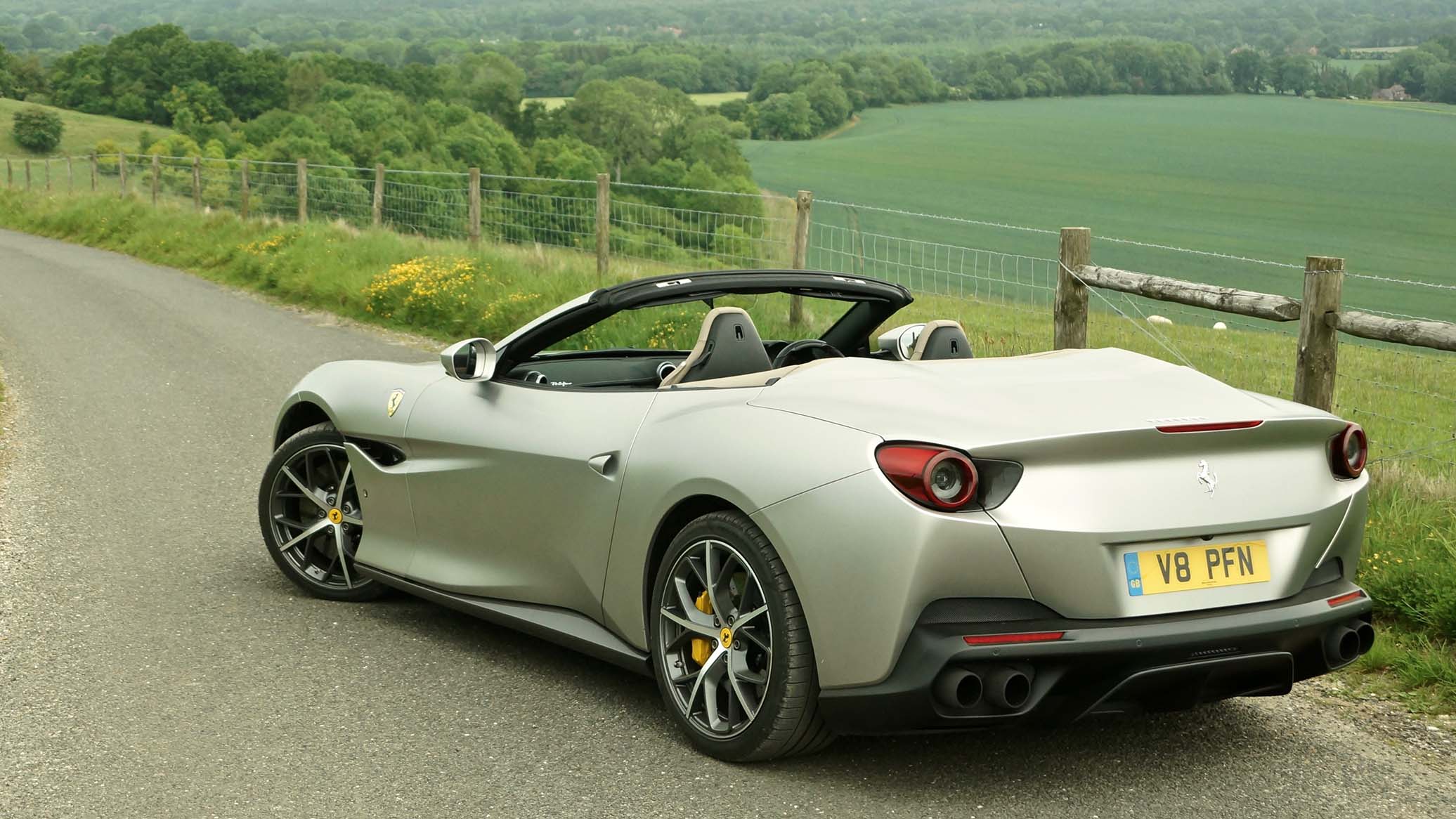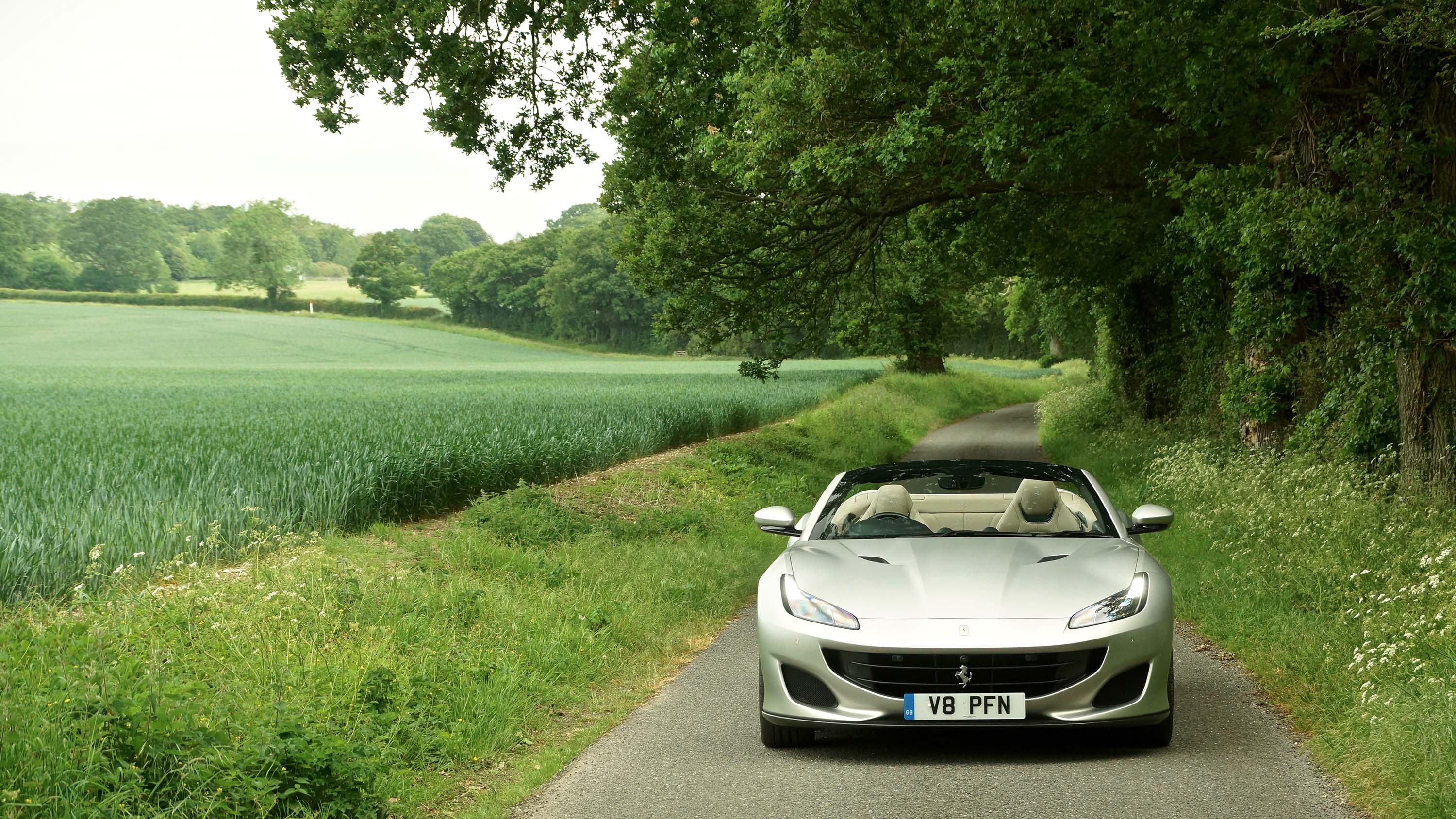
SPEC HIGHLIGHTS
- BHP
600bhp
- 0-62
3.5s
- CO2
245g/km
- Max Speed
199Mph
- Insurance
groupN
The Ferrari formerly known as California T?
The cynical would say that the name change to Portofino disguises the fact not much has been done. But that’s not Ferrari’s style; the Italians like to have a fiddle around with things. And let’s face it they’ve had enough time – the Cali T arrived back in 2014.
Superficially much has been carried over: the same base engine and gearbox, suspension layout and a similar chassis. And the same ethos, this being the daily Ferrari, the most versatile, with the biggest boot, four seats and a folding hard top. Ticks a lot of boxes, and still occupies the entry-level prancing horse position despite the late Sergio Marchionne once insisting in a press conference that this was the wrong car to be the entry level Ferrari. Caused quite a stir at the time. The other prancing horse suits on the platform with him became very still.
What has five years of fiddling brought us?
Detail changes that together add up to something rather worthwhile. Take the chassis. The entire body-in-white was redesigned and better integrated, the result being a 35 per cent increase in structural rigidity. That’s enormous, although I can’t see why Ferrari thought making the old Cali’s A-pillar from 21 separate pieces was ever a sensible idea. It’s now just two.
Think of it as rationalisation. The suspension components are shared with the outgoing Cali T Handling Speciale, but the software that manages them is from the 488. Spring stiffness is up 15.5 and 19 per cent front and rear respectively, overall weight is down 80kg. That’s a really good drop. It’s the first Ferrari GT to have electric power steering (that’s 7 per cent sharper now), the aerodynamics are 6 per cent better (0.31Cd drag factor) and the air con system blows 20 per cent more air, yet is eight decibels quieter. I’ve never thought of Ferrari as detail freaks in any area except engines, but there you go.
And what about the engine itself?
Still a 3.9-litre twin turbo V8. Power is up 40bhp to 592bhp, yet it’s cleaner, more fuel efficient. On paper. In reality we averaged about 17.5mpg over the course of 300 miles of mixed driving, which ain’t that grand when the claim is 26.4mpg. Means that even with 80 litres of fuel on board you’re going to be looking for your next stop after around 250 miles. OK, 300-350 if you’re cruising French autoroutes.
What’s it like to use?
The engine is not the best thing about the Portofino. Or rather one specific element lets it down. No complaints about the speed or the response. This is a very, very fast car. Probably faster than it needs to be to fulfil its drop-top GT role. 62mph in 3.5secs, 124mph in 10.8secs, and the engine – in typical Ferrari fashion – responds more like it’s supercharged. OK, tread on it at 1,500rpm and you’ll find lag, but above 3,000rpm you get instant, neck-wrenching acceleration.
Top Gear
Newsletter
Thank you for subscribing to our newsletter. Look out for your regular round-up of news, reviews and offers in your inbox.
Get all the latest news, reviews and exclusives, direct to your inbox.
So what’s the issue?
The noise. There’s no tune or melody from this flat-plane crank V8. It’s just a flat blare. And we know how much Ferrari likes a bit of volume. With the roof down it’s often just irritatingly invasive. Keep it in Comfort mode and the exhaust valve is meant to stay closed as long as you don’t give it too much throttle. But that’s a bit like attempting to drive a Toyota Prius around in electric-only mode. Theoretically possible, but only if you crawl away from traffic lights at 2mph. Even in Comfort, the exhaust is too throttle/rev sensitive. A car like this needs a richer, mellower engine note. Yes, even if it’s a Ferrari.
Put the roof up?
Tried that. Quieter, but the noise isn’t any more pleasant. Takes 14 seconds to raise/lower and it can be done at up to 25mph, which is a new feature. In the Cali T you had to be stationary. Thank the Portofino’s stiffer chassis – and the redesigned bootlid which leaves the taillights still as the bootlid yawns open to swallow the roof.
Does it help the handling, too?
Let me put it this way: I didn’t expect to like the Portofino. The Old Cali T was a bit brittle, never felt properly keyed into the tarmac, had a good front end, but the rear was less well controlled. The stiffer chassis has created a much better platform for the suspension to work from. It’s the ride quality and lack of scuttle shake – or any shake, indeed – that strikes you first. It feels very together (and this despite those stiffer springs). Not a gentle, cossetting car, but so much better than before in terms of support, precision, comfort. A more than halfway convincing sports car, yet calm over the rough stuff too.
The steering is fast, but Comfort has a bit of slack around the straightahead so feels less aggressive just off centre than Sport. You can’t individually select modes, but the three-position manettino is refreshingly simple. Other issues: the gearbox surges upshifts when you’re charging, but is otherwise relaxed and smooth, and the brakes are nice underfoot. The Portofino is better tuned and integrated than the Cali T, so more trustworthy when you’re going hard, better natured when you’re not and more capable all the time. Best in Comfort mode and using the paddles than Sport and bumpy road dampers, I reckon.
How is it inside?
A bit pinched. If you’re a wallet, phone or rear seat passenger that is. None have that much room to play with. A quick mention for the front seats though, which have been redesigned around a magnesium alloy frame that has enabled commendably thin seat backs, giving passengers in the back some knee space.
There are new controls on the steering wheel, so the wipers and lights are easier to operate and although the seats are quite wide across the beam, they’re also well shaped. Keep the windows up and you won’t need to fiddle around with the inelegant wind deflector, but it’s about time Ferrari developed some kind of system like Merc’s Airscarf to blow hot air on the back of your neck. But this is a Ferrari: of course it’s more important (profitable) to concentrate on the carbon: £1,440 alone for the carbon cupholder. For your equally lightweight beverage.
Other options are equally hilarious, from £2,400 for Apple Carplay to £9,997 for the 20in two tone wheels you see here to £3,360 for the display that tells the passenger how fast you’re actually going. The matte paint? Flat beige (sorry, Aluminium Opaco) is £18,670, helping drive the £166,251 cost of the standard Portofino to £245,167 here.
What about rivals?
Easy, Bentley Continental GTC and Aston DB11 Volante. The Bentley’s out on the comfort flank, the Aston holds the middle ground, the Ferrari is the sportster. All three are handsome devils. I never used to think the Ferrari was, but the rear deck has been sculpted and lowered into a better position, and the car looks more cohesive than before. And drives that way, too.
This might sound ridiculous, but although much improved this is still another Ferrari for Ferrari owners, rather than a car that’s going to nick sales from other brands. It’s a four-seat convertible that’s more vocal than it needs to be. Maybe that’s just me, but in a 488 the noise is appropriate, here it’s overdone. And the Portofino doesn’t need that excess. The chassis has learned how to settle down, it’s about time the exhaust did as well. Still, the best four seat drop top Ferrari of the modern era, but it still lacks the class and elegance of a 250GT SWB Spyder or 275 GTB Spyder. That’s where Ferrari should be drawing its inspiration from. Maybe next time.
7/10
Specs:
3855cc V8 twin-turbo, 592bhp @ 7500rpm, 560lb ft @ 3000-5250rpm
7spd twin clutch, RWD
0-62mph in 3.5sec, 0-124mph in 10.8sec, 199mph max,
26.4mpg, 245g/km CO2
1664kg
Featured

Trending this week
- Car Review
BMW iX3






